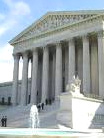| Both sides in a closely watched legal battle over the District of Columbia's strict gun-control law are urging the Supreme Court to hear the case. If the justices agree — a step they may announce as early as Tuesday — the Roberts court is likely to find itself back on the front lines of the culture wars with an intensity unmatched even by the cases on abortion and race that defined the court's last term. The question is whether the Second Amendment to the Constitution protects an individual right to "keep and bear arms." If the answer is yes, as the federal appeals court held in March, the justices must then decide what such an interpretation means for a statute that bars all possession of handguns and that requires any other guns in the home to be disassembled or secured by trigger locks. The Supreme Court has never answered the Second Amendment question directly, and it has been nearly 70 years since the court even approached it obliquely. A decision in 1939, United States v. Miller, held that a sawed-off shotgun was not one of the "arms" to which the Second Amendment referred in its single, densely written, and oddly punctuated sentence: "A well regulated Militia, being necessary to the security of a free State, the right of the people to keep and bear Arms, shall not be infringed." Asked during his confirmation hearing what he thought that sentence meant, Chief Justice John Roberts Jr. responded that the Miller decision had "side-stepped the issue" and had left "very open" the question of whether the Second Amendment protects an individual right as opposed to a collective right. A three-judge panel of the United States Court of Appeals for the District of Columbia Circuit, on which the chief justice formerly sat, ruled in March by a vote of 2 to 1 that "the right in question is individual," not tied to membership in a state militia. On that basis, the court declared that the 31-year-old statute, one of the country's strictest, was unconstitutional. |





